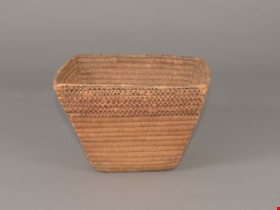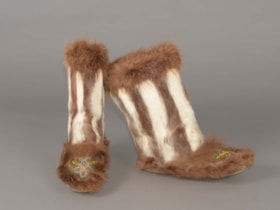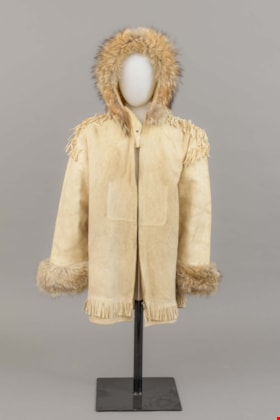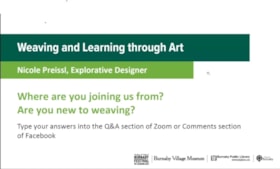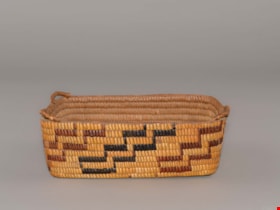Narrow Results By
Subject
- Adornment - Lapel Pins 4
- Advertising Medium 2
- Advertising Medium - Signs and Signboards 1
- Buildings - Civic - Museums 2
- Buildings - Commercial - Restaurants 1
- Buildings - Commercial - Stores 1
- Celebrations - Centennials 2
- Ceremonies 1
- Ceremonies - Weddings 1
- Clothing 200
- Clothing - Accessory 43
- Clothing - Costumes 126
basket
https://search.heritageburnaby.ca/link/museumartifact27529
- Repository
- Burnaby Village Museum
- Accession Code
- HV974.119.3
- Description
- Rectangular coiled cedar root basket with cedar slat foundation, lid has parallel slat construction and is covered with beaded designs edged by imbrication in canary grass. Basket has a flat lid that is hinged to body with leather ties. A mistake was made in how the design was applied to one end of this basket. This is not common as many weavers would correct this mistake. Completely imbricated walls, beaded design on lid. Coast Salish: Sḵwx̱wú7mesh?
- Object History
- The donor reported that the baskets were traded in the early 1920s for clothes by the donor's mother, who lived in North Vancouver. Her mother told her the "Capilano Indians" used to go door to door with their baskets in North Vancouver.
- Diamonds are considered a star pattern and are common to Sḵwx̱wú7mesh and Nlaka’pamux basketry. The main design resembles a ladder or fence and is uncommon.
- Country Made
- Canada
- Province Made
- British Columbia
- Culture
- Sḵwx̱wú7mesh
Images
Documents
berry basket
https://search.heritageburnaby.ca/link/museumartifact27527
- Repository
- Burnaby Village Museum
- Accession Code
- HV974.119.1
- Description
- Trapezoidal shaped, coiled cedar root basket with cedar slat foundation. Finished with an overcast rim with root foundation. Design elements missing from one side of the basket, which is uncommon but has been seen on cradles from the Mount Currie area (Interior Salish: Lil'wat). It was perhaps the side that rests on the wearer's back. Steeply angled sides.
- Coast Salish: Sḵwx̱wú7mesh? Interior Salish: Stl’atl’imx: Lil’wat?
- Object History
- The donor reported that the baskets were traded in the early 1920s for clothes by the donor's mother, who lived in North Vancouver. Her mother told her the "Capilano Indians" used to go door to door with their baskets in North Vancouver.
- Design elements missing from one side of the basket – possibly the side that would have rested against the owner’s back.
- Steeply angled sides keep berries from crushing those at bottom of basket. Work baskets have sides that are more rounded.
- Baskets like these were used with a woven tumpline (wool strap) that was worn against the forehead, while basket was carried on back.
- Country Made
- Canada
- Province Made
- British Columbia
- Culture
- Stl’atl’imx
Images
Documents
mukluks
https://search.heritageburnaby.ca/link/museumartifact84434
- Repository
- Burnaby Village Museum
- Accession Code
- BV008.54.2
- Description
- Pair of mukluks made out of a combination of muskrat, caribou, seal, and moose hide. The musktrat fur goes up the calf of the muklucks. There is bead work on the upper foot and toe area, using yellow, green, blue, red, pink and black beads to make a floral design.
- Object History
- Parka was purchased by donor's wife in either Altin BC or near Perry River, Yukon between 1936 and 1943.
- Country Made
- Canada
- Province Made
- British Columbia
- Site/City Made
- Atlin
Images
Documents
parka
https://search.heritageburnaby.ca/link/museumartifact84433
- Repository
- Burnaby Village Museum
- Accession Code
- BV008.54.1
- Description
- Possible caribou hide parka with fur trimmed hood and cuffs. There are tassels along the shoulders and bottom hem. There is a zipper closure at the front.
- Object History
- Parka was purchased by donor's wife in either Altin BC or near Perry River, Yukon between 1936 and 1943.
- Country Made
- Canada
- Province Made
- British Columbia
- Site/City Made
- Atlin
Images
Documents
Weaving and Learning through Art
https://search.heritageburnaby.ca/link/museumdescription15668
- Repository
- Burnaby Village Museum
- Date
- 11 May 2021
- Collection/Fonds
- Burnaby Village Museum fonds
- Description Level
- Item
- Physical Description
- 1 video recording (mp4) (76 min., 47 sec.) : digital, col., sd., stereo ; 29 fps
- Scope and Content
- Item consists of a video recording of a live Zoom webinar hosted by Burnaby Village Museum Assistant Curator, Kate Petrusa. The webinar is titled "Weaving and Learning through Art" and is presented by Nicole Preissl, Explorative Designer of Sḵwx̱wú7mesh and Stó:lō decent. The Zoom webinar is the f…
- Repository
- Burnaby Village Museum
- Collection/Fonds
- Burnaby Village Museum fonds
- Description Level
- Item
- Physical Description
- 1 video recording (mp4) (76 min., 47 sec.) : digital, col., sd., stereo ; 29 fps
- Material Details
- Presenter: Nicole Preissl
- Host: Kate Petrusa
- Date of Presentation: Tuesday, May 11, 7:00 pm - 8:15 pm
- Total Number of tracks: 1
- Total Length of all tracks: min., sec.
- Recording Device: Zoom video communication platform
- Recording Note: Film was edited from it's original recorded version (90 min., 05 sec.) to edited version (76 min., 47 sec.) for public viewing on Heritage Burnaby.
- Scope and Content
- Item consists of a video recording of a live Zoom webinar hosted by Burnaby Village Museum Assistant Curator, Kate Petrusa. The webinar is titled "Weaving and Learning through Art" and is presented by Nicole Preissl, Explorative Designer of Sḵwx̱wú7mesh and Stó:lō decent. The Zoom webinar is the fifth in a series of six "Neighbourhood Speaker series" webinars exploring a range of topics shared by Indigenous speakers and knowledge keepers that were presented and made available to the public between April 27 and May 12, 2021. The live webinar was also made available on the Burnaby Village Museum's facebook page. Community members were invited to participate by bringing questions during the interactive online session. Nicole supports her presentation with slides and provides a hands on demonstration on weaving. Prior to the webinar, participants were offered materials that were prepared and made available from Burnaby Village Museum. In this interactive webinar, Nicole Preissl, explores the importance of plants within Coast Salish culture and demonstrates the traditional technique of rope-making. In the first part of her presentation, Nicole provides examples of indigenous plants and trees that grow in British Columbia and shares information on thier historical and cultural significance, medicinal and edible properties and how to identify them. Nicole also shares her own experiences and appreciation for natural materials and provides examples of her artwork. In the second half of Nicole's presentation participants are invited to join her demonstration in learning basic weaving techniques. Nicole provides two hands-on demonstrations to follow, one with yarn and one with iris leaves. During and follwing the presentation, Nicole Preissl takes questions from the audience that are moderated by the host, Kate Petrusa.
- History
- Nicole Preissl is an explorative designer who uses natural materials to influence her work. From both Sḵwx̱wú7mesh and Stó:lō decent, she began introducing traditional artistic customs into her practice as a means of connecting to her culture. In her art practice she uses natural fibres and materials to create textile based designs. Her areas of interest are natural plant dyes, weaving Coast Salish style garments and using raw hide to create thought provoking design pieces.
- Creator
- Burnaby Village Museum
- Subjects
- Indigenous peoples - British Columbia - Social life and customs
- Indigenous peoples - British Columbia
- Indigenous peoples - British Columbia - Art
- Plants
- Plants - Flowers
- Plants - Trees
- Indigenous peoples - British Columbia - Baskets
- Indigenous peoples - Implements
- Indigenous peoples - Clothing
- Responsibility
- Petrusa, Kate
- Accession Code
- BV021.17.5
- Access Restriction
- No restrictions
- Reproduction Restriction
- No known restrictions
- Date
- 11 May 2021
- Media Type
- Moving Images
- Notes
- Title based on content of video recording
Images
Video
Weaving and Learning through Art, 11 May 2021
Weaving and Learning through Art, 11 May 2021
https://search.heritageburnaby.ca/media/hpo/_Data/_BVM_Moving_Images/2021_0017_0005_002.mp4work basket
https://search.heritageburnaby.ca/link/museumartifact27528
- Repository
- Burnaby Village Museum
- Accession Code
- HV974.119.2
- Description
- Rectangular coiled cedar root basket with cedar slat foundation and remnants of a loopwork rim. The shiny appearance of this grass suggests it is canary grass. Black dyed and red cherry bark are used for the zigzag designs. Coast Salish: Sḵwx̱wú7mesh?
- Object History
- The donor reported that the baskets were traded in the early 1920s for clothes by the donor's mother, who lived in North Vancouver. Her mother told her the "Capilano Indians" used to go door to door with their baskets in North Vancouver.
- Zig zags are sometimes referred to as lightening or snake tracks.
- Country Made
- Canada
- Province Made
- British Columbia
- Culture
- Sḵwx̱wú7mesh



